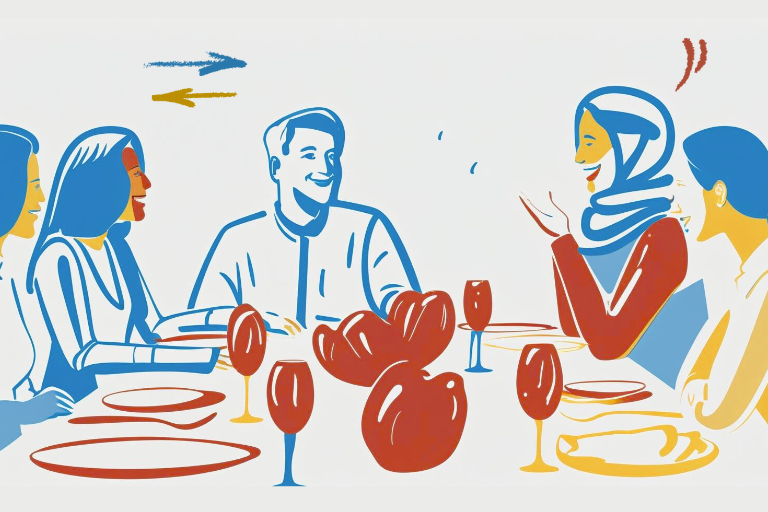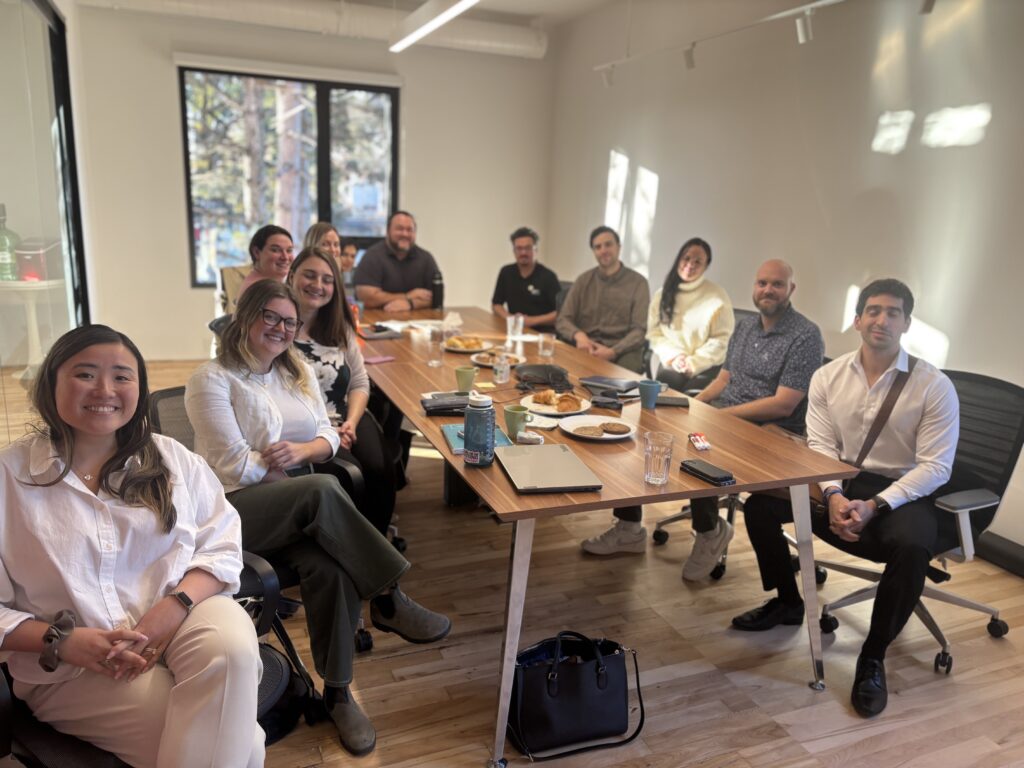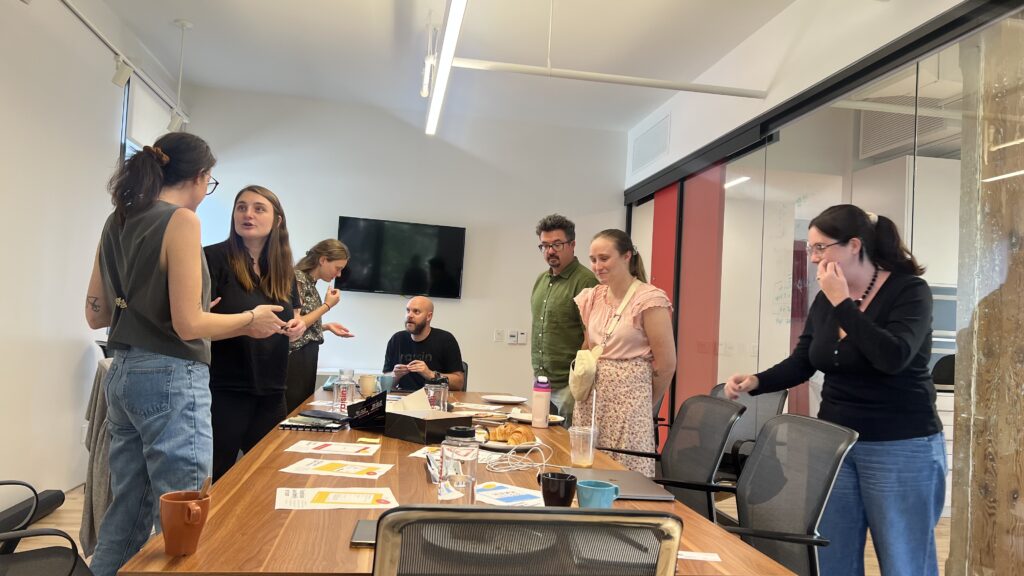The Jeffersonian Dinner: A guide for nonprofit leaders
Updated September 25, 2025
Two Januarys ago, we started hosting Jeffersonian Dinner-style meetups at raisin – small groups of fundraisers swapping stories around our table (or sometimes, on our rooftop). After each one, we hear a version of the same thing: "Finally, a room where I can just talk with people like me."
The format used by Thomas Jefferson is surprisingly simple: 8-14 people, thoughtful questions that invite personal stories, and focus on connection over outcomes.
What we've discovered in the process is that the same challenges we help our nonprofit's address – creating experiences that are transformational, not transactional – apply to our own gatherings, too.
This guide shows you how to bring Jeffersonian Dinners to your board meetings, fundraising events, donor stewardship activities and committees.

Two Januarys ago, we started hosting Jeffersonian Dinner-style meetups at our office.
The thinking behind these gatherings stemmed from our core purpose – that is, to strengthen the human connection that makes giving possible. All of us in the nonprofit space want to do good in different ways… why not build connections across organizations and learn from each other so we can all do even more good?
Other than that, the Jeffersonian Dinners have no specific, goal, which is why it’s been interesting that after each one we consistently hear versions of:
“Finally, a room where I can just talk with people like me.”
Indeed, everyone who attends values most having a forum to discuss their passions, challenges, and ideas with peers. It’s an opportunity that nonprofit leaders rarely have in our oft-siloed sector, yet the desire for these deeper conversations is profound.
What this feedback has helped us is that the same challenges we help our clients address – creating magical digital fundraising experiences – apply to our own internal gatherings, too.
Board meetings, fundraising events, donor stewardship meetings, committee sessions often feel procedural rather than purposeful. They’re things we – as fundraisers, as organizers or as event attendees – begin to do out of obligation.
But, as we’ve discovered through hosting our Dinners, when you create the right conditions for authentic conversation, people actually engage, and form genuine connections.
And the format that makes this possible isn’t complicated or expensive. It’s actually something Thomas Jefferson figured out over 200 years ago.
Jefferson’s Method
Thomas Jefferson understood something fundamental about human nature: meaningful conversation flourishes in intimate settings with thoughtful structure. His famous dinner parties at Monticello brought together diverse leaders around important topics of the day, with goals that align perfectly with nonprofit values:
- Exchanging ideas
- Energizing thought leadership
- Forging new connections
Jefferson wasn’t focused on finding consensus – in fact, he intentionally invited guests with diverse opinions, experiences, and perspectives. The magic happened in the conversation itself.
The four pillars of a Jeffersonian Dinner:
- Small group size (8-14 people) ensure everyone can participate meaningfully
- One “whole-table” conversation shared by the entire table, not multiple side discussions
- Structured questions that invites stories and authentic sharing, always starting with a personal “icebreaker” (don’t be afraid to get deep!)
- Focus on connection over outcomes, consensus or specific discussions

Three ways to use the Jeffersonian format
Jefferson’s format is versatile enough to accomodate a number of different types of gatherings. While we choose to employ it for open discussions, it can be easily adapted for everything from strategic planning retreats to volunteer appreciation dinners. Here’s a few possible applications:
1. Board meetings
Most nonprofit board meetings follow a predictable pattern: reports, financials, old business, new business, adjournment. Board members arrive, slip into their official roles, and leave knowing little more about each other as human beings than when they arrived.
Jeffersonian-style conversations change that up, allowing board members – some of whom might have served together for years – to explore their involvement in your cause in unexpected ways, perhaps even discovering personal connections that they never knew existed. For example, your Executive Director who seemed overwhelmed suddenly feels supported by colleagues who understand their challenges, or the longtime donor reveals why this cause matters so deeply to them.
Sample question: “Share a moment from this quarter when you felt most connected to our mission.”
This simple question accomplishes several things at once. It reconnects board members with your purpose, creates space for personal reflection, and builds trust that carries through the entire meeting. When people start by sharing something meaningful, they’re more likely to engage thoughtfully with the business decisions that follow. Board members often know each other only in their official roles, but starting with personal connection creates an entirely different dynamic – especially if the goal is to collectively advance your mission.
2. Major donor stewardship meetings
We often hear that major donors feel isolated in their philanthropic journeys. They care deeply about causes, but rarely have opportunities to express those feelings with others who understand their experience, or why your mission matters to them. When you cultivate experiences where donors connect with each other and your cause on a deeper level, you’re offering something rare and valuable: community.
Sample icebreaker: “Tell us about a gift you’ve made – to any cause – that produced a real difference in your life or someone else’s.”
This question invites donors to share their philanthropic story, which serves multiple purposes. Other donors hear inspiring examples of giving in action. Your staff gain insights into what motivates generosity. And the donors themselves often rediscover their own passion for making a difference. Creating space for major donors to share with peers builds community around your cause while deepening their individual connection to your mission.
3. Alternative event format
Every nonprofit leader knows the challenge: how do you create fundraising events that energize rather than exhaust your community? The standard gala format – cocktails, dinner, presentation, ask – feels increasingly stale to donors who are overwhelmed by similar events from every organization they support.
The Jeffersonian format offers a refreshing alternative. Instead of asking supporters to sit passively while you present, you’re inviting them into meaningful conversation about the issues they care about and with other interesting people like them. Rather than competing with elaborate productions at hotel ballrooms, you’re creating intimate experiences that money can’t buy.
Sample icebreaker: “Who is someone who opened your eyes to an issue you now care deeply about?”
This approach works because donors are tired of transactional fundraising events that make them feel like ATMs rather than partners in your mission. The Jeffersonian format creates the kind of authentic experience that strengthens long-term commitment to your cause. Supporters leave feeling energized about your work and connected to each other – the foundation for sustainable community building.
Step-by-step guide to running your Jeffersonian Dinner
Once you’ve decided to try the Jeffersonian format, success depends on thoughtful preparation and skilled facilitation. Like any meaningful conversation, it requires intention, but the process is simpler than you might expect. Jeff Walker outlines it well in the video below. The key is understanding that you’re creating conditions for conversation, not orchestrating outcomes.
Planning and invitations
Invite 8-14 people with diverse perspectives but equal standing. Like Jefferson, you’re really trying to meet two goals:
- Equal standing: This doesn’t mean everyone needs identical titles or status, but rather that each person should feel they belong at the table. you might to choose to mix longtime supporters with newer ones, different generations, various professional backgrounds. The goal is creative tension, not conflict – people who can learn from each other’s different experiences and viewpoints.
- Meaningful conversation: In that sweet spot of 8-14 people, every voice can be heard and every story can be told.We’ve learned this the hard way – smaller feels incomplete, like something is missing. Larger prevents meaningful participation from everyone. Eight people feels intimate; fourteen people approaches the upper limit of what allows for meaningful sharing.
Set expectations
In your invitation, explain the format and the evening’s topic. Let people know they’ll be asked to share personally and that the conversation will be structured around the table. Some people love spontaneous discussion; others need time to prepare mentally. Give them that gift by being clear about what you’re asking of them.
Choose your setting
Outside of the one time we gathered at a picnic table on our rooftop patio, we’ve found that a board room table in our offices works. Obviously, though, a dinner table works best. The key is to find one space where everyone can see and hear each other clearly. Circle or oval configurations are ideal because they subtly reinforce that this is a conversation among equals. Note: Definitely avoid theatre-style seating or long rectangular tables that make half the group feel distant.
Crafting the Right Questions
The questions you ask will determine whether your Jeffersonian Dinner soars or stumbles. Great questions feel deceptively simple but invite surprisingly rich responses. They should feel personal without being intrusive, specific enough to prompt stories but broad enough for diverse interpretation.
The icebreaker question is your most important tool. It should elicit personal stories rather than opinions or theories, connect to your evening’s theme, be answerable in about two minutes, and be impossible to answer with just “yes” or “no.” The best icebreakers make people think, “I’ve never been asked that before,” while simultaneously making them feel excited to share their answer.
Follow-up questions should flow naturally from broad to specific, like an inverted pyramid. Prepare 3-4 questions, knowing you may only need 1-2 if conversation flows naturally. The art – and is an art in some ways – is in reading the room. Sometimes a single powerful question can carry an entire evening. Other times, you’ll need the full progression to dive deeper into your theme.
Think of your questions as invitations rather than interrogations. You’re not seeking specific information or trying to prove a point. You’re trying to create opportunities for people to share openly, knowing that when people speak with passion it creates naturally connection.
Sample question progressions:
For a donor stewardship dinner:
- “Tell us about a gift that made a real difference” (icebreaker)
- “What drew you to this particular cause initially?”
- “What gives you the most hope about the work we’re doing together?”
Facilitating the Conversation
Here’s where the Jeffersonian format proves its worth, and where many well-intentioned attempts at meaningful conversation fall short. The difference between a memorable evening and an awkward experience often comes down to facilitation skills that can be learned and practiced.
This is responsibility of your dinner’s host, or “Jefferson”. If you’re the Jefferson for your dinner, consider how you’ll do these things well:
Go around the table
For each question, give every person a chance to speak uninterrupted. This simple rule changes everything. It ensures equal participation and prevents the loudest voices from dominating, but more importantly, it signals that every person’s perspective matters equally. In most meetings, the same people talk while others listen politely. The round-the-table approach democratizes the conversation in a way that often surprises participants.

Listen actively
As the facilitator, your job is to listen, not to respond to every comment. This restraint is harder than it sounds, especially when someone shares something that resonates deeply with your experience. Resist the urge to jump in with your own story or analysis. Instead, occasionally summarize themes you’re hearing or ask gentle follow-up questions that invite deeper sharing: “That sounds like it was a turning point for you. What changed after that?”
Embrace silence
If someone needs a moment to think, let them have it. Comfortable silence is better than rushed answers. Some of the most profound responses come after a pause for reflection. Your role is to hold that space confidently, signaling to the group that taking time to find the right words is not only acceptable but valued.
End with takeaways
Always close by asking each person: “What will you take from this conversation?” This helps solidify insights and creates a natural conclusion that feels purposeful rather than arbitrary. Often, the takeaways round produces some of the evening’s most meaningful moments as people synthesize what they’ve heard and felt.
Following Up
The conversation doesn’t end when people push back from the table. In fact, how you handle the immediate aftermath often determines whether this becomes a one-time interesting experience or the beginning of something deeper.
Here’s your checklist:
- Send a thank you: Within a few days, send a personal note thanking participants and highlighting a few themes that emerged. Just like good donor stewardhship, take the time to mention specific moments or insights that stood out.
- Share connections: If appropriate, connect participants who discovered common interests or complementary expertise. You might facilitate an introduction between the board member who mentioned struggling with volunteer recruitment and the donor who has professional HR experience. We’ve found that these organic connections often prove more valuable than any formal networking event.
- Act on insights: If actionable ideas emerged, let people know how you plan to follow up on them. Maybe someone shared an innovative approach to community engagement, or several people identified a gap in your programming. Following up shows that you were listening not just for the sake of conversation, but because you value their input.
What not to do
The shape of the Jeffersonian Dinner is at once rigid, and free-flowing. That’s kind of the beauty of it. But the latitude it provides can lead to some common pitfalls (which, in some cases, we’ve learned the hard way). Here are some things to avoid:
- The “sales pitch” trap: Resist turning this into a fundraising presentation. Trust that deeper connection will lead to stronger support over time.
- Too much debate: If conversation becomes argumentative, gently redirect: “That’s an interesting perspective. Let’s hear from others around the table.”
- Monologues: Some people love to talk. Set time expectations upfront and kindly redirect lengthy responses: “That’s a great start – let’s come back to that after we’ve heard from everyone.”
- Awkward silence: I realize I said to embrace silence, but not everyone is comfortable sharing immediately. Try: “Take a moment to think about it, and we’ll come back to you.”
Make it your own
The flexibility of Jefferson’s design, though, means you can really make it your own. You might host a 90-minute committee meeting that starts with one thoughtful question, or create a full evening event built around a compelling theme. The key is maintaining the core principles: small groups, structured sharing, and genuine focus on human connection.
We’ve seen firsthand just how powerful the Jeffersonian Dinner can be. When leaders have space to share challenges and insights with peers, everyone benefits. The connections formed in these intimate settings often lead to collaborations, mentorships, and innovations that extend far beyond the dinner table.
Just the same, your cause deserves supporters who are deeply connected to your mission, board members who understand each other as humans, and a community that feels genuinely engaged with your work. The Jeffersonian Dinner format offers a simple, proven way to create those connections.
After all, in a sector built on the belief that human generosity can change the world, shouldn’t our gatherings reflect that same spirit of human connection?